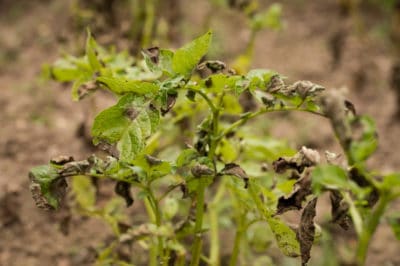Historical Impact
Late blight is thought to have originated in Mexico. It probably traveled to other regions of the world when tubers were exported. The infection was a major contributing factor to the emigration of Irish and Scots families in the 1840s. These populations were primarily growing a variety of potato known as the Irish Lumper, which was highly susceptible to blight. Millions of people died of starvation in these famines.
Recognizing Late Blight
Late blight typically appears first as dark blotches on potato leaf tips and plant stems. It may also infect tomatoes – the symptoms are similar. The next stage is the development of white mold under the leaves. Infected tubers will develop patches of gray or brown on the skins; the patches are reddish brown underneath. A characteristic foul odor emanates from mushy spots in the tuber.
Blight Infection
Blight is a mold that is spread by spores. While the disease is killed by warm, dry weather, the spores can remain in the soil for some time and can also travel on the wind. Tubers that are missed during harvest or those left in cull piles may harbor the organism and allow it to spread at the start of a new growing season.
Weather and Blight
Potatoes can be grown in all USDA Zones, but those with cool, moist springs are more likely to have blight problems. Disease development and spread is favored by:
- Temperatures of 54 to 64°F (12 to 18°C).
- Environments with high humidity or in rainy springs.
- Temperatures below 59°F (°15C), which favor spore production.
- Temperatures of 68 to 75°F (20 to 24°C), which promote development of lesions.
Managing Potato Blight
Once an infection begins, the best course of action is to immediately remove and burn infected plants. The disease is difficult to control and most anti-fungals are non-organic commercial chemicals. One of the few organic fungicides is copper sulfate. Irrigation practices can help manage humidity – don’t water plants overhead and don’t allow the soil to become soggy.
Other Strategies
Rotating potatoes may be helpful in managing infected soil. However, spores can travel on the wind. Always plant disease-free seed potatoes. There are a few blight-resistant varieties – Defender, Jacqueline Lee, Sarpo Mira, Sarpo Axona and Ozette. Romano, Remarka, Teena, Torridon, Stirling and Cara are slower than some to develop blight. Early varieties tend to be more susceptible than late varieties.
